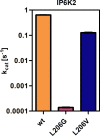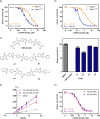An unconventional gatekeeper mutation sensitizes inositol hexakisphosphate kinases to an allosteric inhibitor
- PMID: 37843983
- PMCID: PMC10578927
- DOI: 10.7554/eLife.88982
An unconventional gatekeeper mutation sensitizes inositol hexakisphosphate kinases to an allosteric inhibitor
Abstract
Inositol hexakisphosphate kinases (IP6Ks) are emerging as relevant pharmacological targets because a multitude of disease-related phenotypes has been associated with their function. While the development of potent IP6K inhibitors is gaining momentum, a pharmacological tool to distinguish the mammalian isozymes is still lacking. Here, we implemented an analog-sensitive approach for IP6Ks and performed a high-throughput screen to identify suitable lead compounds. The most promising hit, FMP-201300, exhibited high potency and selectivity toward the unique valine gatekeeper mutants of IP6K1 and IP6K2, compared to the respective wild-type (WT) kinases. Biochemical validation experiments revealed an allosteric mechanism of action that was corroborated by hydrogen deuterium exchange mass spectrometry measurements. The latter analysis suggested that displacement of the αC helix, caused by the gatekeeper mutation, facilitates the binding of FMP-201300 to an allosteric pocket adjacent to the ATP-binding site. FMP-201300 therefore serves as a valuable springboard for the further development of compounds that can selectively target the three mammalian IP6Ks; either as analog-sensitive kinase inhibitors or as an allosteric lead compound for the WT kinases.
Keywords: allosteric inhibitor; analog-sensitive; biochemistry; chemical biology; human; inositol phosphate; kinase.
© 2023, Aguirre et al.
Conflict of interest statement
TA, GD, SH, MN, CS, VH, AS, Jv, DF No competing interests declared
Figures















Update of
- doi: 10.1101/2023.04.26.538378
- doi: 10.7554/eLife.88982.1
- doi: 10.7554/eLife.88982.2
Similar articles
-
Insights into the roles of inositol hexakisphosphate kinase 1 (IP6K1) in mammalian cellular processes.J Biol Chem. 2024 Apr;300(4):107116. doi: 10.1016/j.jbc.2024.107116. Epub 2024 Feb 24. J Biol Chem. 2024. PMID: 38403246 Free PMC article. Review.
-
Deletion of inositol hexakisphosphate kinase 1 (IP6K1) reduces cell migration and invasion, conferring protection from aerodigestive tract carcinoma in mice.Cell Signal. 2016 Aug;28(8):1124-36. doi: 10.1016/j.cellsig.2016.04.011. Epub 2016 Apr 30. Cell Signal. 2016. PMID: 27140681 Free PMC article.
-
Characterization of a selective inhibitor of inositol hexakisphosphate kinases: use in defining biological roles and metabolic relationships of inositol pyrophosphates.J Biol Chem. 2009 Apr 17;284(16):10571-82. doi: 10.1074/jbc.M900752200. Epub 2009 Feb 10. J Biol Chem. 2009. PMID: 19208622 Free PMC article.
-
Use of Protein Kinase-Focused Compound Libraries for the Discovery of New Inositol Phosphate Kinase Inhibitors.SLAS Discov. 2018 Oct;23(9):982-988. doi: 10.1177/2472555218775323. Epub 2018 May 29. SLAS Discov. 2018. PMID: 29842835 Free PMC article.
-
Targeting the Inositol Pyrophosphate Biosynthetic Enzymes in Metabolic Diseases.Molecules. 2020 Mar 19;25(6):1403. doi: 10.3390/molecules25061403. Molecules. 2020. PMID: 32204420 Free PMC article. Review.
Cited by
-
Semi-enzymatic synthesis and application of 13C-isotopically labelled inositol-(1,4,5)-trisphosphate.RSC Chem Biol. 2025 Jul 23. doi: 10.1039/d5cb00139k. Online ahead of print. RSC Chem Biol. 2025. PMID: 40735387 Free PMC article.
References
Publication types
MeSH terms
Substances
LinkOut - more resources
Full Text Sources
Research Materials

